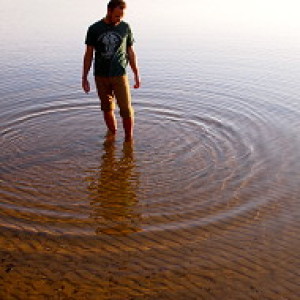Spice Islands
I awoke to the deep resonant blasts of the giant Pelni steamer arriving into Banda harbor at the crack of dawn this morning. I woke Kevin and went out to see off all these good people I have spent time with here. I am sad to see them go, and wonder if I will see any of them again. Such is the nature of travel though. The hardest part for me is having to always say so many good byes.
Stevie and Guenther, the French Guadalupe - German couple, Lauri from Finland, and Coen from Holland are all heading onward to the distant and even more remote Kai Islands a couple days from now with me. This allows me almost another week in the Bandas. We sat there and waved them farewell from the dock. The boat is so big it seems to dwarf the town but we could pick out their tall shapes on the decks full of people as we waved them off and took in the spectacle.
We who stayed, sat with our legs off the dock eying the curious visitors of the incoming tide. From the dock we watched an octopus slink along the rocks completely cryptic and camuflauged. We saw long speckled flute fish suspended in the water. We even saw a big green alien eyed mantis shrimp foraging along the bottom. It is like a Discovery Channel documentary just below the harbor dock here folks. Amazing.
After breakfast we caught a local boat across the channel to the Palua Aie about an hour distant. Palua Aie is even more dreamy, quite, and laid back than the Bandas. Banda has a few roads and mostly foot or bicycle traffic, but Aie doesn't even have roads, which is even more lovely. There are only a series of crisscrossing sidewalks through the village and foot trails traversing the islands. In the village the houses are pious, simple, and clean adorned with fruit trees and ornamentals out front. Everywhere are mango, banana, jackfruit, rose apple, nutmeg, hibiscus, and bouganvilla. It smells like tropical honey with a hint of sea salt...
At the recommendation of my friend Chinta in Banda we stayed at a small family guesthouse called the Green Coconut. It is right on the water and the perfect place to unwind, read, and write literally far and away from it all. A rare second floor balcony looks down on the small beach below, a raised reef in fact, and the distant unrelenting empty blue of the Banda Sea stretching to the eyes limit.
Washed up corals, shells, and old blue-white pottery fragments litter the beach. Amazingly, the pottery is left over from the Dutch VOC, or Dutch East India Company vessels that ruled the spice trade from these islands hundreds of years ago. The water is truly aquamarine here and the sound of the waves so rythmic it makes me feel lost and disoriented. It feel so distant and remote I am almost uneasy. Like the sea faring explorers of old I am off on the edge of the known world.
Waiting out the hottest part of the day we wandering the village in the late afternoon light. Getting lost on our way to the shore we came across a field of kids playing soccer by what must have been the local school. Soon our friend Coen had joined in and many kids came to investigate us. Nearby a rose apple tree was in full fruit and a couple of boys climbed up to feast in the low branches showering us with fruit.
Before dusk we wandered on to a footpath snaking through the forest past the famous nutmeg gardens of this island, coveted by the likes of sultans and European merchants alike. Short, shrub like nutmegs dot the trail overshadowed by tall buttressed kenari almond trees just like in the olden days of the spice trade. The nutmeg, mace, and almonds produced by this agroforestry system are still important to these islands today adding to the timeless traditions and history of this place.
As I wandered through these "gardens" I couldn?t help thinking on what rich and diverse agroforestry systems they are. Bananas, mangos, small plots of cassava, and myriad smaller fruit trees are all interspersed beneath the kenari-nutmeg canopy. Walking through it feels like walking through a lush tropical forest, yet this whole landscape is a planted garden of fruits, spices, and food crops.
I want to study and write about this agroecology system now and am surprised to have never heard of it before. In many ways it is nostalgic of the coffee agroecosystems of the Caribbean. In the broader picture of things this entire eco-region we are in right now is known as Wallacia, named after Alfred Russel Wallace's discoveries here. Wallacia is a biodiversity hotspot and the most diverse place on Earth for tropical reefs and marine life. I wonder if this agroecosystem could be a tool for conservation on these islands or throughout Muluku? There seems to be great potential for sustainable livlihoods, fair price incentives, and conservation values....
Finally arriving at the beach we found gorgeous sliver of white sand wrapping around the island as far as we could see hedged in by veiny ficus trees and the typical stunningly clear water. We rested in the sand under an overhanging ficus tree right on the beach and waited for the sunset.
Hatta Island rises up in the distance of the near horizon and the small silhouttes of fishermen returning home in their canoes is a picture perfect backdrop to the fading creamy orange panorama of the sunset.
Many thanks for this day.
- 0
- 0
- Olympus E-P1
- f/11.0
- 38mm
- 200

Comments
Sign in or get an account to comment.


